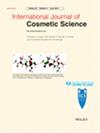Enhancement of water homeostasis by glycerol and urea in stratum corneum and the difference in the activity between them
Abstract
Objective
To investigate the role of glycerol and urea in water-holding mechanisms in the stratum corneum (SC) using synchrotron X-ray diffraction and to clarify differences in activity.
Methods
Structural changes in human SC samples treated with water, glycerol, and urea aqueous solutions were measured during drying, focusing on the short lamellar, orthorhombic hydrocarbon-chain packing, and coiled-coil α-helix structure of the soft keratin, which are affected by water.
Results
During drying of the treated SC, the coiled-coil α-helix chain distance decreased due to the removal of bound water. The reduction rate was suppressed in the SC treated with glycerol, followed by those treated with urea. This result suggests that water binding via glycerol is strongest to soft keratin, followed by urea. Furthermore, for the short lamellar structure, we calculated the volume associated with the hydrocarbon chain, its head group, and water in the head group, from which we estimated the quantity of water removal. Initially, the volume was unchanged because no water was removed. Once the SC was treated with glycerol and urea, the volume-unchanged interval was longer than that in the SC treated with water alone. Therefore, glycerol and urea strengthened water retention within the water layer.
Conclusion
Taken together with the results obtained from the solid-state NMR analysis of the soft keratin, the present results indicate that glycerol enhances the retention of the maximum bound water of 25 wt% in the SC, whereas urea retains it somewhat weakly. Therefore, from the results of in vivo confocal Raman microscopy, which indicated that the water content near the surface of the normal skin is approximately 25 wt%, it is deduced that the maximum bound water content is strongly held at the skin surface with the aid of glycerol or urea. On the other hand, it was found that the lipid lamellar structure serves to regulate the water content to maintain it at 25 wt% and glycerol and urea work to enhance this regulation mechanism. Owing to the above two mechanisms, the water content at the skin surface is maintained at 25 wt% homeostatically, and the homeostatic state is strengthened by glycerol and urea.


 求助内容:
求助内容: 应助结果提醒方式:
应助结果提醒方式:


